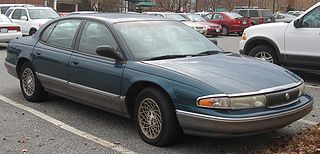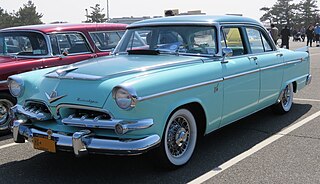
Plymouth was a brand of automobiles produced by Chrysler Corporation and its successor DaimlerChrysler. The brand was launched in 1928 to compete in what was then described as the "low-priced" market segment that was dominated by Chevrolet and Ford. It became a high-volume seller for the automaker until the late 1990s. Plymouth cars were marketed primarily in the United States. The brand was withdrawn from the marketplace in 2001. The Plymouth models that were produced up to then were either discontinued or rebranded as Chrysler or Dodge.

The Mitsubishi Galant is an automobile which was produced by Japanese manufacturer Mitsubishi from 1969 until 2012. The model name was derived from the French word galant, meaning "chivalrous". There have been nine distinct generations with total cumulative sales exceeding five million units. It began as a compact sedan, but over the course of its life evolved into a mid-size car. Initial production was based in Japan, but from 1994 the American market was served by vehicles assembled at the former Diamond-Star Motors (DSM) facility in Normal, Illinois.

The Chrysler New Yorker is an automobile model that was produced by Chrysler from 1940 until 1996, serving for several decades as either the brand's flagship model or as a junior sedan to the Chrysler Imperial, the latter during the years in which the Imperial name was used within the Chrysler lineup rather than as a standalone brand.

The Dodge Dynasty is a mid-size four-door sedan that was marketed by the Dodge division of Chrysler Corporation from 1988 until 1993 model years. Serving as the direct successor of the Dodge 600 sedan, the Dynasty was slotted between the Dodge Spirit and Dodge Monaco in the Dodge sedan line.

The Dodge Dart is a line of large passenger cars produced by Dodge from the 1959 to 1976 model years in North America, with production extended to later years in various other markets.

The K-car platform was a key automotive design platform introduced by Chrysler Corporation for the 1981 model year, featuring a transverse engine, front-wheel drive, independent front and semi-independent rear suspension configuration—a stark departure from the company's previous reliance on solid axle, rear-drive unibody configurations during the 1970s. Derived from Chrysler's L-cars, the Plymouth Horizon and Dodge Omni, the platform was developed just as the company faltered in the market, at first underpinning a modest range of compact/mid-size sedans and wagons—and eventually underpinning nearly fifty different models, including all-wheel drive variants—and playing a vital role in the company's subsequent resurgence.

The Dodge 600 is a mid-size car that was sold by Dodge from the 1983 to 1988 model year. Serving as the replacement of the Dodge 400 coupe and convertible, the 600 also included a four-door sedan. Within the Dodge car line, the 600 was slotted between the Dodge Aries and the Dodge Diplomat.

The Chrysler LeBaron, also known as the Imperial LeBaron, is a line of automobiles built by Chrysler from 1931 to 1941 and from 1955 to 1995. The model was introduced in 1931, with a body manufactured by LeBaron, and competed with other luxury cars of the era such as Lincoln and Packard. After purchasing LeBaron with its parent Briggs Manufacturing Company, Chrysler introduced the luxury make Imperial in 1955, and sold automobiles under the name Imperial LeBaron until 1975. Chrysler discontinued the Imperial brand in 1975, and reintroduced the Chrysler LeBaron in 1977 to what was then Chrysler's lowest priced model.

The Dodge Colt is a subcompact car that was manufactured by Mitsubishi Motors and marketed by Dodge for model years 1971 to 1994 as captive imports. Rebadged variants include the Plymouth Champ and Plymouth Colt, both were marketed by Plymouth.

The Chrysler Sebring is a line of mid-size automobiles that was sold from 1995 through 2010 by Chrysler. Three generations of convertibles, two generations of sedans, and two generations of coupes were produced. Although the coupe shared the same name and some styling cues, it was mechanically unrelated to the other Sebring models.
The JA platform was Chrysler's smaller complement to the LH cars which were larger than the Ks, and a direct size replacement for the last extended K cars, the Acclaim and Spirit. It was a mid-size front-wheel drive automobile platform that was the basis for the Cloud Cars — the Chrysler Cirrus/Dodge Stratus/Plymouth Breeze starting in 1994. Like the LH, it was a cab forward design. While this platform was numerically successful, the highest volume for family cars competing against cars like the Taurus, Accord, or Camry would move to the LH platform cars, which were often classified as full-size.

The Dodge Diplomat is an American mid-size car that was produced by Dodge from 1977 to 1989. At launch, it shared a common design with the Chrysler LeBaron and for much of its later production run was the counterpart of the more upscale Chrysler Fifth Avenue and lower priced Plymouth Gran Fury. It was also sold in Mexico between 1981 and 1982 as the Dodge Dart, and in Colombia as the Dodge Coronet. The Diplomat was initially offered in a coupe and a sedan; in 1978, station wagons were added as replacements for the discontinued full-sized C-body wagons.

The Dodge Monaco is an automobile that was marketed by the Dodge division of Chrysler Corporation. Introduced as the flagship of the Dodge product line, the Monaco was introduced for 1965 to replace the Custom 880, then later joining as a sub-model of the Dodge Polara. During its production, the Monaco was offered in multiple body configurations, including two-door and four-door hardtop sedans, four-door sedans, two-door convertibles, and station wagons.

The Dodge Coronet is an automobile that was marketed by Dodge in seven generations, and shared nameplates with the same bodyshell with varying levels of equipment installed. Introduced as a full-size car in 1949, it was the division's highest trim line and moved to the lowest level starting in 1955 through 1959. The name was reintroduced on intermediate-sized models from the 1965 until 1976 model years. Muscle car versions were available starting in 1965 with the 383 and 426 wedge cu in Chrysler RB engine, followed in 1966 by the powerful 426 cu in Chrysler Hemi. Other performance models included the "Superbee", and featured, the 383 cu in Magnum, among other engine options. The nameplate "coronet" is a type of crown worn by royalty.

The Plymouth Fury is a model of automobile that was produced by Plymouth from 1955 until 1989. It was introduced for the 1956 model year as a sub-series of the Plymouth Belvedere, becoming a separate series one level above the contemporary Belvedere for 1959. The Fury was a full-size car from 1959 until 1961, then a mid-size car from 1962 until 1964, again, a full-size car from 1965 through 1974, and again, a mid-size car from 1975 through 1978. From 1975 until 1977, the Fury was sold alongside the full-size Plymouth Gran Fury. In 1978, the B-body Fury was the largest Plymouth, and by 1979, there was no large Plymouth. This product gap was filled in 1980 with the R-body Gran Fury, followed by the M-body Fury in 1982. Production of the last V8, RWD Plymouth Fury ended at the Kenosha Main assembly plant in Kenosha, WI, on December 23, 1988. Unlike its sibling brand, Dodge, Plymouth would not live to see the resurgence of the large, V8/RWD sedan.

The Chrysler Saratoga is an automobile built by Chrysler. The nameplate was used from 1939 to 1952 and from 1957 to 1960 in the U.S. market, in Canada through 1965, and in Europe from 1989 to 1995. In the beginning, it was introduced as a sport luxury model, using the Straight Eight engine from the Chrysler New Yorker which was more formal, and the Imperial which had graduated to special order limousine.

The Chrysler Town & Country is an automobile which was manufactured by Chrysler from 1940 to 1942 and from 1945 to 1988 with production interrupted during World War II. Primarily produced as a luxury station wagon, the Town & Country was also available in "woodie" four-door sedan, two-door hardtop and convertible body styles from 1947 to 1950, 1968 to 1969 and from 1983 to 1986. The 1988 model year was the last for the station wagon until the 1990 model year when Chrysler reintroduced the Town & Country nameplate as the rebadged variant Chrysler Town & Country minivan.

The Dodge Polara is an automobile introduced in the United States for the 1960 model year as Dodge's top-of-the-line full-size car. After the introduction of the Dodge Custom 880 in 1962, the Polara nameplate designated a step below the full-sized best-trimmed Dodge model; the Polara that year had been downsized to what was in effect intermediate, or mid-size status. In its various forms, the Polara name was used by Dodge until 1973, when its position in Dodge's line-up was replaced by the Dodge Monaco.

The Newport was a name used by Chrysler for both a hardtop body designation and also for its lowest priced model between 1961 and 1981. Chrysler first used the Newport name on a 1940 show car, of which five vehicles were produced. From 1950 to 1956, the Newport name was then used to designate any Chrysler model with a hardtop body style. In 1961, Chrysler introduced the Newport as a new, low-priced model, offering large, comfortable two- and four-door Chrysler models that were modestly priced compared with the Chrysler 300, the Chrysler New Yorker and the Imperial. For 1961, the Newport was priced below the Chrysler Windsor in the Windsor's final year.

The 1955 Dodge car lineup, consisting of the entry-level Coronet, Royal, and ornate Custom Royal, was a major departure for the company. Driven almost out of business in 1953 and 1954, the Chrysler Corporation was revived with a $250 million loan from Prudential and new models designed by Virgil Exner. The Dodge lineup was positioned as the mainstream line in Chrysler's hierarchy, between DeSoto and Plymouth.




















